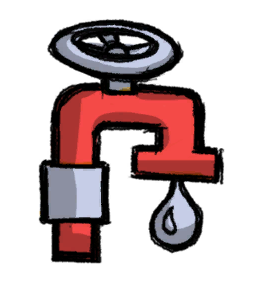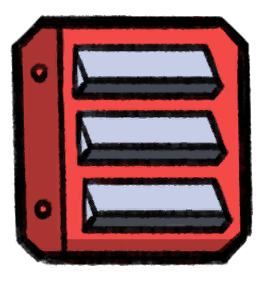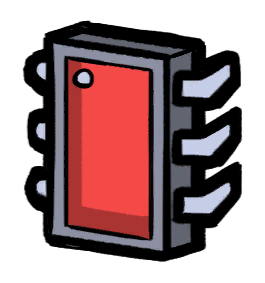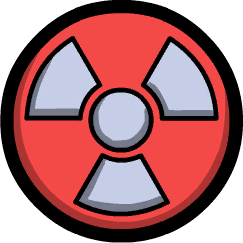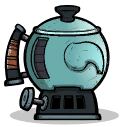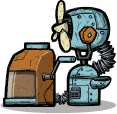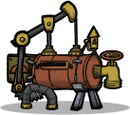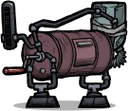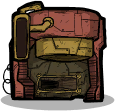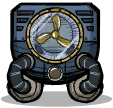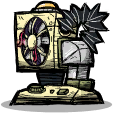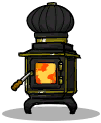Thermo Aquatuner
Thermo Aquatuner cools the liquid piped through it and absorbs the Heat itself.
If the environment around the Thermo Aquatuner cannot absorb its heat, it will quickly overheat. Due to its high heat output it is recommended to submerge it in a liquid, as gasses cannot exchange temperatures with it fast enough when the machine is working full time.
Use of Steel or Thermium
Due to the massive amounts of heat that this device can take away and invest into itself, the choices of materials for this device is very limited if Overheating is to be avoided. In the early and mid-game, the most reliable material is ![]() Steel. In the late game,
Steel. In the late game, ![]() Thermium is the best choice.
Thermium is the best choice.
Use of Thermo Sensor
A Thermo Sensor is also very much recommended - indeed, required - for efficient use and control of this device. Setting the sensor close or next to the Aquatuner is wise; this can give a measure of both the temperature of the Aquatuner and the fluids that it is immersed in. If the Aquatuner is made of ![]() Steel or
Steel or ![]() Thermium, the heat transfer will be fast enough to reliably control the temperature of the Aquatuner and the fluids that are soaking heat from it.
Thermium, the heat transfer will be fast enough to reliably control the temperature of the Aquatuner and the fluids that are soaking heat from it.
Mechanics
The Thermo Aquatuner (as well as the Thermo Regulator) works by taking heat from anything piped into it and applying that heat to itself, and does not produce its own heat. As this is heat-neutral, cooling it with its own output will cause it to maintain its temperature, assuming no other heat sources or sinks are present.
The amount of heat moved depends on the type and amount of liquid piped in. Each packet of liquid has 14 °C removed from it, regardless of the Specific Heat Capacity (SHC) of the fluid or the amount. It is therefore best to use liquids with a high SHC ( ![]() Water,
Water, ![]() Polluted Water,
Polluted Water, ![]() Super Coolant) and to ensure all packets sent in are 10 kg (it consumes 1.2 kJ per packet, not per 10 kg), in order to make the most of the 1.2 kW power requirement.
Super Coolant) and to ensure all packets sent in are 10 kg (it consumes 1.2 kJ per packet, not per 10 kg), in order to make the most of the 1.2 kW power requirement.
The Aquatuner does not respect freezing temperatures of liquids, and will damage the output pipe if liquids are cooled below their freezing temperature.
The Aquatuner is the only building capable of reliably producing liquid oxygen and hydrogen as it has a minimum output temperature of -272 °C. The Thermo Regulator also has the same minimum temperature, but there is no gas suitable for cooling hydrogen to the necessary temperatures.
| Name | SHC (DTU/°C)/g |
TC DTU/m/s/°C |
Heat moved DTU/s |
Self heating °C/s for |
Freezing point °C |
Vaporization point °C |
|---|---|---|---|---|---|---|
| |
1.690 | 2.000 | 236,600 | 2.012 | -40.15 | 399.85 |
| |
1.760 | 2.000 | 246,400 | 2.095 | -57.15 | 538.85 |
| |
2.191 | 0.200 | 306,740 | 2.608 | -50.15 | 538.85 |
| |
2.460 | 0.171 | 344,400 | 2.928 | -114.05 | 78.35 |
| |
3.400 | 0.609 | 476,000 | 4.048 | -22.50 | 102.75 |
| |
4.100 | 0.609 | 574,000 | 4.881 | -7.50 | 99.69 |
| |
4.100 | 0.609 | 574,000 | 4.881 | -82.50 | 160.00 |
| |
4.179 | 0.609 | 585,060 | 4.975 | -0.65 | 99.35 |
| |
4.179 | 0.580 | 585,060 | 4.975 | -20.65 | 119.35 |
| |
7.440 | 6.000 | 1,041,600 | 8.857 | 26.85 | 526.85 |
| |
8.440 | 9.460 | 1,181,600 | 10.048 | -271.15 | 436.85 |
Formula for Heat Moved (assuming 10kg packets of liquid) is Heat Moved = SHC × 14C × 10,000g. For example, for ![]() Nuclear Waste, Heat Moved = 7.440 × 14 × 10,000 = 1,041,600 DTU/s.
Nuclear Waste, Heat Moved = 7.440 × 14 × 10,000 = 1,041,600 DTU/s.
In addition to the Heat Moved, the Aquatuner itself will heat up and if it is not sufficiently cooled down, it will overheat and take damage. The amount of self heat will depend on the liquid used and the metal used to build the Aquatuner. The formula for Self Heating = Heat Moved / (mass of Aquatuner × SHC of metal used / 5). Note the mass of the Aquatuner is fixed at 1,200,000g and as a building it has its thermal mass divided by 5. For example, the formula for Self Heating °C/s for a steel Aquatuner using water: Self Heating = Heat Moved (585,060) / (Mass of Aquatuner (1,200,000) × SHC of steel (0.49) / 5) = 585,060 / 117,600 = 4.975 °C/s.
Any liquid can be used, but these are most common as they have desirable properties; ![]() Super Coolant has the largest heat capacity. Thermal conductivity is listed above, but has no effect on the operation of the Thermo Aquatuner; it is important only when the coolant exchanges heat with the environment. Notably, buildings that dump heat into a coolant piped into them, such as the Metal Refinery, ignore thermal conductivity.
Super Coolant has the largest heat capacity. Thermal conductivity is listed above, but has no effect on the operation of the Thermo Aquatuner; it is important only when the coolant exchanges heat with the environment. Notably, buildings that dump heat into a coolant piped into them, such as the Metal Refinery, ignore thermal conductivity.
Note: There is a lower temperature limit of -272.1 °C (1 K). ![]() Super Coolant is the only liquid capable of reaching such a temperature without freezing. However, the Thermo Aquatuner will continue to operate, consuming 1200 W and generating no heat in the process.
Super Coolant is the only liquid capable of reaching such a temperature without freezing. However, the Thermo Aquatuner will continue to operate, consuming 1200 W and generating no heat in the process.
Caution on the Use of Thermium and Super Coolant
Both high-end manufactured materials vastly increases the Aquatuner's ability and efficiency at exchanging heat - but also vastly changes the amounts of heat involved. Using these materials require more careful control of not just the temperatures of the Aquatuner and the fluids that it is immersed in, but also what the fluids and Aquatuner is drawing heat from. It is very easy to excessively cool a region without this additional care.
Use to melt metal
The Aquatuner takes about 1.25 cycles (750 seconds) to completely become disabled from overheating.
Therefore, if an Aquatuner is used to cool a full pipe of ![]() Water or
Water or ![]() Polluted Water continuously while sitting in Vacuum, it will melt before the damage from overheating breaks it. It is recommended to disable auto-repair to avoid wasting metal. Note that since buildings have 1/5 the Specific Heat Capacity of the material they are made of, the heat in the resulting liquid metal will be 5 times what was displaced by the Aquatuner. This trick is particularly useful to melt
Polluted Water continuously while sitting in Vacuum, it will melt before the damage from overheating breaks it. It is recommended to disable auto-repair to avoid wasting metal. Note that since buildings have 1/5 the Specific Heat Capacity of the material they are made of, the heat in the resulting liquid metal will be 5 times what was displaced by the Aquatuner. This trick is particularly useful to melt ![]() Steel, since
Steel, since ![]() Liquid Steel is used for a wide array of advanced industrial processes.
Liquid Steel is used for a wide array of advanced industrial processes.
Tips
Despite the similar SHC, ![]() Nectar
Nectar ![]() and
and ![]() Polluted Water should be picked over
Polluted Water should be picked over ![]() Water for the -82.50°C and -20.65°C freezing points, respectively. Maintenance on burst pipes tends to be very tricky, so the low freezing point provides much more wiggle room when trying to balance the coolant receiver.
Water for the -82.50°C and -20.65°C freezing points, respectively. Maintenance on burst pipes tends to be very tricky, so the low freezing point provides much more wiggle room when trying to balance the coolant receiver.
While ![]() Nuclear Waste
Nuclear Waste ![]() can be used to move very large amounts of heat, care must be taken as to not let it go below the relatively high freezing point of 26.85°C, and the pipe network doesn't stop. When stops, the nuclear waste becomes "contained" in the Aquatuner, which will make it leak from the Aquatuner.
can be used to move very large amounts of heat, care must be taken as to not let it go below the relatively high freezing point of 26.85°C, and the pipe network doesn't stop. When stops, the nuclear waste becomes "contained" in the Aquatuner, which will make it leak from the Aquatuner.





